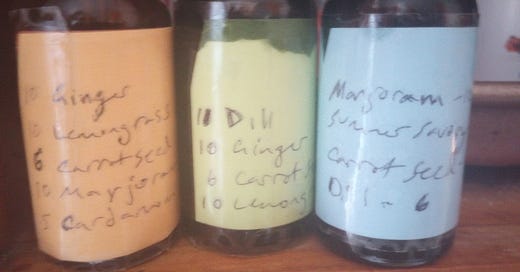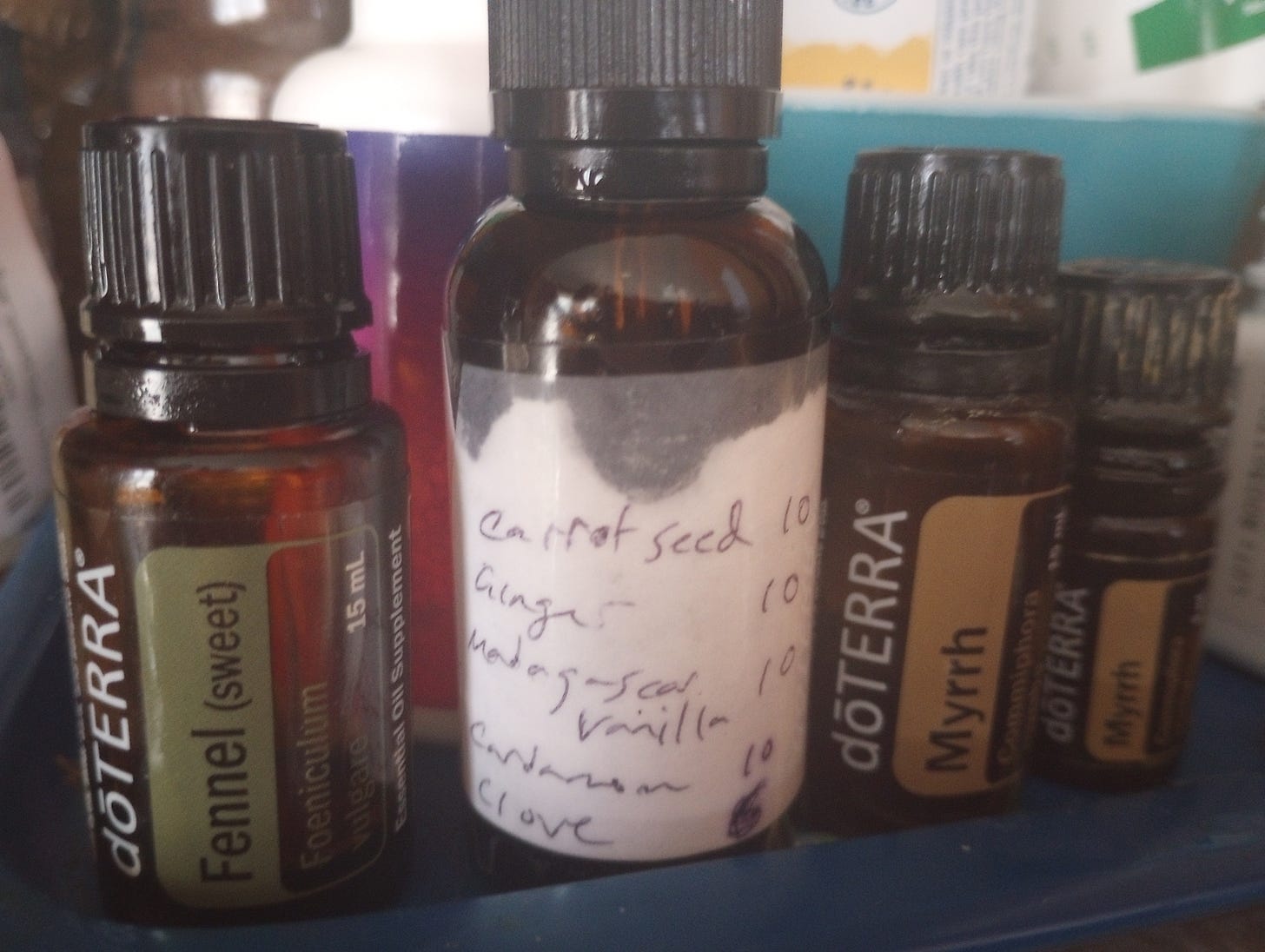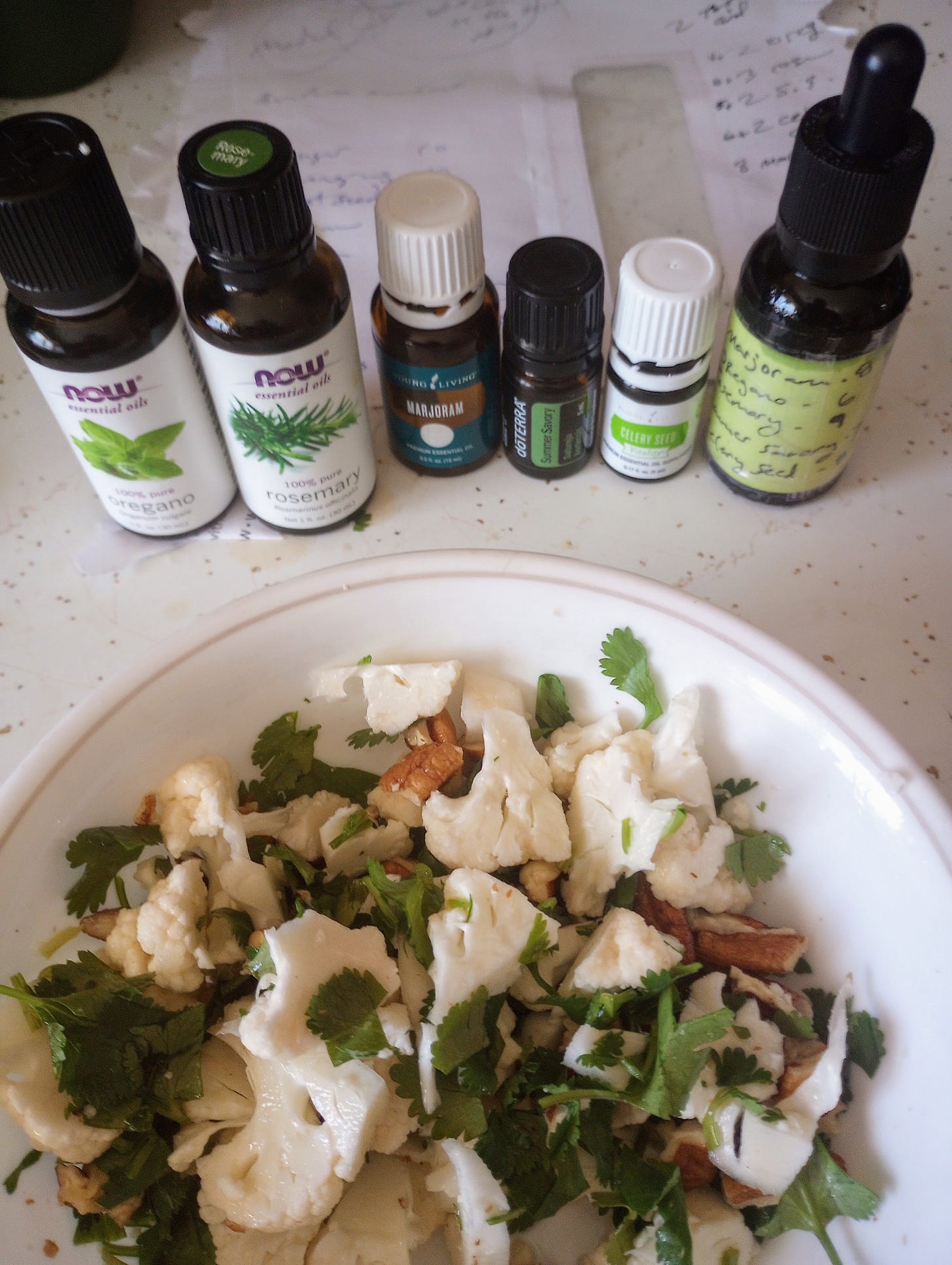Cooking with essential oils
* this will be my first million dollar product line.
Experimenting with essential oils in cooking led to a greater appreciation for whole herbs and spices. They add more to a cooked food, more lasting flavor or more full-bodied flavor.
Once used to vanilla extract, an alcohol based extract, the essential oil of vanilla seems incomplete. Yes, vanilla aroma is there, but less.
ESSENTIAL OILS ARE AMONG OTHER POTENT SEASONINGS USED AT THE TABLE - TO THE DINER'S PREFERENCE.
However essential oils can also add a lot of flavor that is super fast to use. Best practice is to add the volatile oil immediately before eating the food - add it at the end of cooking or at the table individually like we add salt and pepper to taste.
Hot pepper sauce is an example of a phytonutrient food that is added to taste at the table. Powdered Sumac is also used in that way and powdered lime or lemon in Middle Eastern cuisine.
Essential oils are so potent that one drop might be too much and one drop of several oils to make a blended flavor, would be way too much for a single serving.
Making a diluted blend allows a diner to add a mixed flavor of oils at the table to a single serving and easily be able to add more if they want a stronger flavor.
ESSENTIAL OILS IN COOKING OR BAKING - 12 DROPS IN A BATCH OF 24 SERVINGS IS GIVING ABOUT A HALF A DROP PER SERVING. DON'T OVERHEAT!
I also use oils in cooking and baking - easy yes, but the flavor just seems less substantial than using the whole spices or herbs.
In a spicy baked good, about 24 muffins worth, I will add 5-6 drops of Clove, Cardamom, and 6-8 of Ginger. It does give a zingy flavor and aroma but the powdered spices give a fuller flavor, in my opinion.
To test my theory, that flavor blends in a dilution would be nice to use for single servings, I made four blends. Three for use in food, diluted in Fractionated Coconut Oil, and one to use in my hot structured water beverage, diluted in MCT Coconut Oil. *Organic oils.
For my experiment I had some empty one ounce, 30 ml eyedropper bottles. 30 milliliters is about 500 drops. I made a one tenth dilution by adding about 50 drops of essential oil to the 30 ml bottle and filled it with liquid coconut oil. This turned out to be a mild dilution. I might add a half dropper or two to a bowl of soup or salad.
And for my hot beverage, I might add one or two dropperfuls to three mug batch of blended MCT oil structured water hot beverage. Picture below has oils I add to my hot beverage mixture, individually or in varied combinations.
Aside - Myrrh oil likes to turn right back into a tree resin given the opportunity. It's bottle becomes a sticky mess that tastes good. In the photo above there is an empty 5 ml Myrrh bottle next to a 15 ml Myrrh bottle and a 30 ml eyedropper bottle with my Carrot Cake blend of oils. To the left is Fennel essential oil which is yummy with fruit or in a beverage and if soothes histamine symptoms.
Carrot Cake Blend: 10 drops each of Carrot Seed, Ginger, Madagascar Vanilla, and Cardamom essential oils, and 6 drops of Clove essential oil.
Ginger blend - I use with soup: 10 drops each Ginger, Lemongrass, Marjoram, 6 drops Carrot seed, and 5 drops Cardamom. **this blend is good for a Thai soup broth effect but, I will probably adjust it slightly.
Dill blend - I like this blend on salad: 11 drops Dill seed, 10 drops Ginger and Lemongrass, and 6 drops Carrot seed.
Marjoram blend - I like this blend with hot soup particularly for the immediate Marjoram and Savory aroma or on salad: 10 drops each Marjoram, Summer Savory, and Carrot seed, 6 drops Dill seed.
Carrot seed oil may have liver healing benefits. They all have healing benefits 😃 that topic needs a different post. This is the “it tastes delicious" post
The flavor of Carrot seed oil is carrot-like but excess can become more bitter than desirable. I don't eat carrots because of my retinoid toxicity risk so it is nice that the essential oil seems okay for me. Dill seed tastes like dill pickles which I love and can't have because fermented foods are histamine foods. It is also a prominent flavor in a blend - meaning make it the dominant note or use less than other oils in a blend - similar with the Carrot seed oil.
Marjoram and Summer Savory are like spending a day in a sunny meadow.
The aroma when adding to a hot soup is immediate, so at the table use is a good place for essential oils in my experience, when pre-diluted. I could increase number of drops used by doubling probably, but found that fairly dilute is convenient. Add a dropperful over the top of the soup at the beginning and add another half way through.
It is better for the oil quality of the single oils to not open the lids very often. These blends have lasted me about a month already. I need to refill the hot beverage Carrot Cake blend and the other three are half full.
30 ml bottle = 30 eye droppers full.
I made a new batch of Carrot Cake blend for structured water hot beverages and I added some Myrrh to it, to reduce frustration with the sticky Myrrh bottle.
Carrot & Myrrh Cake - 10-11 drops each Myrrh, Carrot Seed, Ginger, Madagascar Vanilla, and Cardamom essential oils, and 6-8 drops of Clove essential oil.
I also made a new salad or soup blend - Italian Salad Pizazz
Marjoram oil - 8 drops, Oregano - 6, Rosemary - 9, Summer savory - 7, Celery Seed - 8 drops.
Fill with a little more than two tablespoons of Fractionated Coconut oil, but then the bottle overflows when you put the eyedropper in. <User error> Two tablespoons is ~ 30 mL or one ounce.
I used the last lettuce leaves experimenting with the blend so this salad is chopped cauliflower with cilantro and pecans and two not full eyedroppers of Italian Salad Pizazz and one tablespoon of apple cider vinegar. Crunchy and really good. Now I want more.
The dilution level is good for instant use and did not sting at all topically - the overflow became hand lotion. Oregano oil can sting topically if not diluted enough and is recommended for edible, diluted in a capsule use, as a therapeutic antimicrobial.
Food flavor drops to prevent picky eating? Starting with a baby’s formula? . . . It’s an idea I had a long time ago.
An advantage of leaving the blends fairly dilute is that makes them handy for use with children or for people who aren’t used to strong flavors. There is also an advantage for picky eaters or for those with mental quirks about specks in their food - essential oil blends are not adding specks of herbs and spices in the food.
The very dilute blend might even be tolerable and safe for older babies. Food flavor drops is an old idea for me. I noticed as a counselor that people like to take action - they want to ‘DO’ something about an issue. It may give a sense of control when a situation seems confusing, new, or out of control. As a counselor for early childhood care, there was often a need to encourage people to STOP doing something that they were doing. Having a substitute action to offer instead can make it easier to encourage changing the other habit.
As a lactation educator, I learned that breast milk may decrease picky eating because the baby is getting vegetable and other flavors in the breast milk - it isn’t always the exact same sweet taste. So I thought formula feeding parents might love to be able to add veggie essence drops to their formula feedings to help introduce more flavor early in a baby’s life. Essential oils are veggie essence drops but would be way too potent unless greatly diluted.
My math may be wrong but the Marjoram blend with 36 drops in a bottle with a capacity of 500 drops would make it a 7% dilution. Giving baby one drop of the blend would be giving 0.07 drop of the combined essential oils. *Hypothetically, this is not individualized health care guidance or a recommendation. An eye dropperful would be about one milliliter and it might contain 17 drops of the dilution and 1.2 drops of the combined essential oils. Topical guidance for use of essential oils for infants is dilute 1 drop to 20 drops carrier oil, which is a 5% dilution. A blend intended for topical use with infants might be reduced then to a total of 25 drops in the 30 ml/500 drop bottle.
~~
Two related posts:
Edible essential oils & why we benefit from using the fragrant gifts from nature, (deNutrients.Substack).
and Myrrh, (deNutrients.Substack).
Edible essential oils & why we benefit from using the fragrant gifts from nature.
Some herbs are better sources of phytonutrients that have a protective effect against cancerous changes - but all plants are good sources because it helps protect the plant too. Harsh sun can cause DNA change from UV light in plants (Dinkova-Kostova 2008
Myrrh;
Myrrh resin is an ancient medicinal product that I tried as an essential oil. It seems to have nootropic benefits - mind clearing. Reduction in neuroinflammation is a reported benefit. It also has antimicrobial benefits and has shown potential against CoV. (
Disclaimer This information is being provided for educational purposes within the guidelines of Fair Use and is not intended to provide individual health guidance.










Fun, interesting, and actionable post! A friend of mine once suggested touching a toothpick to the top of the plastic valve thingy on the top of the bottle of essential oil as a way to grab less than a drop, then mixing it with your food.
Language is beautiful. Your descriptions appeal to the senses. I let my imagination follow your lead. I didn’t even see the typos.